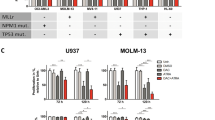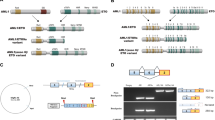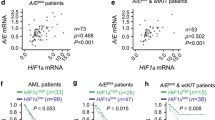Abstract
The acute promyelocytic leukemia-specific PML–RARα fusion protein is a dominant-negative transcriptional repressor of retinoic acid receptor (RAR) target genes, which recruits HDAC and corepressor proteins and inhibits coactivators. Another oncogenic transcription factor, AML1–ETO, was proposed to cause an HDAC-dependent repression of RAR target genes. The RAR target RARβ2 gene has been reported to be frequently silenced by hypermethylation in many types of cancer cells. We examined the methylation status of the RARβ2 and asked if demethylation could reverse ATRA resistance in ATRA-resistant PML–RARα and AML1–ETO-positive cells. PML–RARα positive NB4 and its ATRA-resistant subvariant MR2 and AML1–ETO expressing Kasumi-1 cells had heterozygous methylation of RARβ2. Although DNA methyltransferase inhibitor 5-aza-2′-deoxycytidine partially reversed RARβ2 CpG methylation in these cells, it did not significantly enhance ATRA-induced RARβ2 mRNA expression and induction of maturation. However, the histone acetylase inhibitor SAHA combined with ATRA significantly reactivated RARβ2 mRNA both in NB4 and MR2 cells with degradation of PML–RARα, which was associated with maturation. In contrast, SAHA did not affect AML1–ETO levels and failed to induce RARβ2 expression and maturation in Kasumi-1 cells. In primary AML samples, RARβ2 expression was uniformly low; however, no specific correlation was observed between the methylation of the RARβ2 gene and expression of the fusion proteins, PML–RARα, and AML1–ETO. These results demonstrate that oncogenic PML–RARα and AML1–ETO translocations are rarely associated with RARβ2 promoter methylation in primary AML samples.














Similar content being viewed by others
References
Esteller M (2002) CpG island hypermethylation and tumor suppressor genes: a booming present, a brighter future. Oncogene 21:5427–5440
Okano M, Xie S, Li E (1998) Cloning and characterization of a family of novel mammalian DNA (cytosine-5) methyltransferases. Nat Genet 19:219–220
Fuks F, Burgers WA, Brehm A, Hughes-Davies L, Kouzarides T (2000) DNA methyltransferase Dnmt1 associates with histone deacetylase activity. Nat Genet 24:88–91
Jones PL, Veenstra GJ, Wade PA, Vermaak D, Kass SU, Landsberger N, Strouboulis J, Wolffe AP (1998) Methylated DNA and MeCP2 recruit histone deacetylase to repress transcription. Nat Genet 19:187–191
Kondo Y, Shen L, Issa JP (2003) Critical role of histone methylation in tumor suppressor gene silencing in colorectal cancer. Mol Cell Biol 23:206–215
Nan X, Ng HH, Johnson CA, Laherty CD, Turner BM, Eisenman RN, Bird A (1998) Transcriptional repression by the methyl-CpG-binding protein MeCP2 involves a histone deacetylase complex. Nature 393:386–389
Bachman KE, Park BH, Rhee I, Rajagopalan H, Herman JG, Baylin SB, Kinzler KW, Vogelstein B (2003) Histone modifications and silencing prior to DNA methylation of a tumor suppressor gene. Cancer Cell 3:89–95
Ferrara FF, Fazi F, Bianchini A, Padula F, Gelmetti V, Minucci S, Mancini M, Pelicci PG, Lo CF, Nervi C (2001) Histone deacetylase-targeted treatment restores retinoic acid signaling and differentiation in acute myeloid leukemia. Cancer Res 61:2–7
He LZ, Guidez F, Tribioli C, Peruzzi D, Ruthardt M, Zelent A, Pandolfi PP (1998) Distinct interactions of PML–RARalpha and PLZF–RARalpha with co-repressors determine differential responses to RA in APL. Nat Genet 18:126–135
Lin RJ, Nagy L, Inoue S, Shao W, Miller WH Jr, Evans RM (1998) Role of the histone deacetylase complex in acute promyelocytic leukaemia. Nature 391:811–814
Li Y, Dawson MI, Agadir A, Lee MO, Jong L, Hobbs PD, Zhang XK (1998) Regulation of RAR beta expression by RAR- and RXR-selective retinoids in human lung cancer cell lines: effect on growth inhibition and apoptosis induction. Int J Cancer 75:88–95
Houle B, Rochette-Egly C, Bradley WE (1993) Tumor-suppressive effect of the retinoic acid receptor beta in human epidermoid lung cancer cells. Proc Natl Acad Sci USA 90:985–989
Liu Y, Lee M-O, Wang H-G, Li Y, Hashimoto Y, Klaus M, Reed JC, Zhang X-K (1996) Retinoic acid receptor beta mediates the growth-inhibitory effect of retinoic acid by promoting apoptosis in human breast cancer cells. Mol Cell Biol 16:1138–1149
Li C, Wan YJ (1998) Differentiation and antiproliferation effects of retinoic acid receptor beta in hepatoma cells. Cancer Lett 124:205–211
Mendelsohn C, Ruberte E, Lemeur M, Morriss-Kay G, Chambon P (1991) Developmental analysis of the retinoic acid-inducible RAR-beta 2 promoter in transgenic animals. Development 113:723–734
Youssef EM, Estecio MR, Issa JP (2004) Methylation and regulation of expression of different retinoic acid receptor beta isoforms in human colon cancer. Cancer Biol Ther 3:82–86
Faria TN, Mendelsohn C, Chambon P, Gudas LJ (1999) The targeted disruption of both alleles of RARbeta(2) in F9 cells results in the loss of retinoic acid-associated growth arrest. J Biol Chem 274:26783–26788
Di Croce L, Raker VA, Corsaro M, Fazi F, Fanelli M, Faretta M, Fuks F, Lo CF, Kouzarides T, Nervi C, Minucci S, Pelicci PG (2002) Methyltransferase recruitment and DNA hypermethylation of target promoters by an oncogenic transcription factor. Science 295:1079–1082
Bassan R, Chiodini B, Lerede T, Giussani U, Oldani E, Buelli M, Rossi A, Viero P, Rambaldi A, Barbui T (2002) Prolonged administration of all-trans retinoic acid in combination with intensive chemotherapy and G-CSF for adult acute myelogenous leukemia: single-centre pilot study in different risk groups. Hematol J 3:193–200
Estey EH, Thall PF, Pierce S, Cortes J, Beran M, Kantarjian H, Keating MJ, Andreeff M, Freireich E (1999) Randomized phase II study of fludarabine + cytosine arabinoside + idarubicin + All-trans retinoic acid+granulocyte-colony stimulating factor in poor prognosis newly-diagnosed non-APL AML and MDS. Blood 93:2478–2484
Lanotte M, Martin-Thouvenin V, Najman S, Balerini P, Valensi F, Berger R (1991) NB4, a maturation inducible cell line with t(15;17) marker isolated from a human acute promyelocytic leukemia (M3). Blood 77:1080–1086
Shao W, Benedetti L, Lamph WW, Nervi C, Miller WH Jr (1997) A retinoid-resistant acute promyelocytic leukemia subclone expresses a dominant negative PML–RAR alpha mutation. Blood 89:4282–4289
Asou H, Tashiro S, Hamamoto K, Otsuji A, Kita K, Kamada N (1991) Establishment of a human acute myeloid leukemia cell line (Kasumi-1) with 8;21 chromosome translocation. Blood 77:2031–2036
Milella M, Kornblau SM, Estrov Z, Carter BZ, Lapillonne H, Harris D, Konopleva M, Zhao S, Estey E, Andreeff M (2001) Therapeutic targeting of the MEK/MAPK signal transduction module in acute myeloid leukemia. J Clin Invest 108:851–859
Rochette-Egly C, Lutz Y, Saunders M, Scheuer I, Gaub MP, Chambon P (1991) Retinoic acid receptor gamma: specific immunodetection and phosphorylation. J Cell Biol 115:535–545
Clark SJ, Harrison J, Paul CL, Frommer M (1994) High sensitivity mapping of methylated cytosines. Nucleic Acids Res 22:2990–2997
Xiong Z, Laird PW (1997) COBRA: a sensitive and quantitative DNA methylation assay. Nucleic Acids Res 25:2532–2534
Esteller M, Fraga MF, Paz MF, Campo E, Colomer D, Novo FJ, Calasanz MJ, Galm O, Guo M, Benitez J, Herman JG (2002) Cancer epigenetics and methylation. Science 297:1807–1808
Espino PS, Drobic B, Dunn KL, Davie JR (2005) Histone modifications as a platform for cancer therapy. J Cell Biochem 94:1088–1102
Clayton AL, Mahadevan LC (2003) MAP kinase-mediated phosphoacetylation of histone H3 and inducible gene regulation. FEBS Lett 546:51–58
Mongan NP, Gudas LJ (2005) Valproic acid, in combination with all-trans retinoic acid and 5-aza-2′-deoxycytidine, restores expression of silenced RARbeta2 in breast cancer cells. Mol Cancer Ther 4:477–486
Suh YA, Lee HY, Virmani A, Wong J, Mann KK, Miller WH Jr, Gazdar A, Kurie JM (2002) Loss of retinoic acid receptor beta gene expression is linked to aberrant histone H3 acetylation in lung cancer cell lines. Cancer Res 62:3945–3949
Zhu J, Gianni M, Kopf E, Honore N, Chelbi-Alix M, Koken M, Quignon F, Rochette-Egly C, de The H (1999) Retinoic acid induces proteasome-dependent degradation of retinoic acid receptor alpha (RARalpha) and oncogenic RARalpha fusion proteins. Proc Natl Acad Sci USA 96:14807–14812
Duprez E, Lillehaug JR, Naoe T, Lanotte M (1996) cAMP signalling is decisive for recovery of nuclear bodies (PODs) during maturation of RA-resistant t (15;17) promyelocytic leukemia NB4 cells expressing PML–RAR alpha. Oncogene 12:2451–2459
Epping MT, Wang L, Edel MJ, Carlee L, Hernandez M, Bernards R (2005) The human tumor antigen PRAME is a dominant repressor of retinoic acid receptor signaling. Cell 122:835–847
Liu M, Iavarone A, Freedman LP (1996) Transcriptional activation of the human p21(WAF1/CIP1) gene by retinoic acid receptor. Correlation with retinoid induction of U937 cell differentiation. J Biol Chem 271:31723–31728
Manor D, Shmidt EN, Budhu A, Flesken-Nikitin A, Zgola M, Page R, Nikitin AY, Noy N (2003) Mammary carcinoma suppression by cellular retinoic acid binding protein-II. Cancer Res 63:4426–4433
White JA, Beckett-Jones B, Guo YD, Dilworth FJ, Bonasoro J, Jones G, Petkovich M (1997) cDNA cloning of human retinoic acid-metabolizing enzyme (hP450RAI) identifies a novel family of cytochromes P450. J Biol Chem 272:18538–18541
Boylan JF, Lufkin T, Achkar CC, Taneja R, Chambon P, Gudas LJ (1995) Targeted disruption of retinoic acid receptor alpha (RAR alpha) and RAR gamma results in receptor-specific alterations in retinoic acid-mediated differentiation and retinoic acid metabolism. Mol Cell Biol 15:843–851
Freemantle SJ, Kerley JS, Olsen SL, Gross RH, Spinella MJ (2002) Developmentally-related candidate retinoic acid target genes regulated early during neuronal differentiation of human embryonal carcinoma. Oncogene 21:2880–2889
Fu WN, Bertoni F, Kelsey SM, McElwaine SM, Cotter FE, Newland AC, Jia L (2003) Role of DNA methylation in the suppression of Apaf-1 protein in human leukaemia. Oncogene 22:451–455
Soengas MS, Capodieci P, Polsky D, Mora J, Esteller M, Opitz-Araya X, McCombie R, Herman JG, Gerald WL, Lazebnik YA, Cordon-Cardo C, Lowe SW (2001) Inactivation of the apoptosis effector Apaf-1 in malignant melanoma. Nature 409:207–211
Teitz T, Wei T, Valentine MB, Vanin EF, Grenet J, Valentine VA, Behm FG, Look AT, Lahti JM, Kidd VJ (2000) Caspase 8 is deleted or silenced preferentially in childhood neuroblastomas with amplification of MYCN. Nat Med 6:529–535
Larisch S, Yi Y, Lotan R, Kerner H, Eimerl S, Tony PW, Gottfried Y, Birkey RS, de Caestecker MP, Danielpour D, Book-Melamed N, Timberg R, Duckett CS, Lechleider RJ, Steller H, Orly J, Kim SJ, Roberts AB (2000) A novel mitochondrial septin-like protein, ARTS, mediates apoptosis dependent on its P-loop motif. Nat Cell Biol 2:915–921
Issa JP, Garcia-Manero G, Giles FJ, Mannari R, Thomas D, Faderl S, Bayar E, Lyons J, Rosenfeld CS, Cortes J, Kantarjian HM (2004) Phase 1 study of low-dose prolonged exposure schedules of the hypomethylating agent 5-aza-2′-deoxycytidine (decitabine) in hematopoietic malignancies. Blood 103:1635–1640
Acknowledgements
We thank Betty Notzon for manuscript review, Nobuko Tanaka, Hiroaki Miyajima, and Akemi Koyanagi for technical assistance, and Rosemarie Lauzon for help in the preparation of the manuscript. This study is supported in part by grants from the National Cancer Institute (PO1 CA55164, PO1 CA49639, RO1 CA89346, and CA16672) to M.A. and the Leukemia and Lymphoma Society (6097-02) to M.K.
Author information
Authors and Affiliations
Corresponding author
Rights and permissions
About this article
Cite this article
Tabe, Y., Konopleva, M., Kondo, Y. et al. PML-RARα and AML1–ETO translocations are rarely associated with methylation of the RARβ2 promoter. Ann Hematol 85, 689–704 (2006). https://doi.org/10.1007/s00277-006-0148-7
Received:
Accepted:
Published:
Issue Date:
DOI: https://doi.org/10.1007/s00277-006-0148-7




